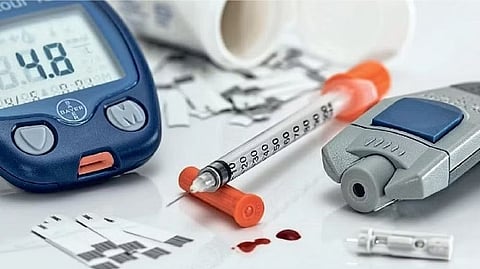

ZURICH: In diabetes, the body either generates no or very little insulin. Thus, the external injection or pump delivery of this hormone is necessary for diabetics. To improve the lives of these individuals, researchers from the Department of Biosystems Science and Engineering at ETH Zurich in Basel, headed by Martin Fussenegger, are searching for ways to create and deliver insulin directly to the body.
One such approach that researchers are working on involves creating capsules that can be injected into the body and contain designer cells that produce insulin. In recent years, researchers have examined and used various triggers, including light, temperature, and electric fields, to be able to control from the outside when and how much insulin the cells release into the blood.
Fussenegger and his colleagues have now developed another, novel stimulation method: they use music to trigger the cells to release insulin within minutes. This works especially well with “We Will Rock You,” a global hit by British rock band, Queen. To make the insulin-producing cells receptive to sound waves, the researchers used a protein from the bacterium E. coli. Such proteins respond to mechanical stimuli and are common in animals and bacteria. The protein is located in the membrane of the bacterium and regulates the influx of calcium ions into the cell interior.
The researchers have incorporated the blueprint of this bacterial ion channel into human insulin-producing cells. This lets these cells create the ion channel themselves and embed it in their membrane. As scientists have been able to show, the channel in these cells opens in response to sound, allowing positively charged calcium ions to flow into the cell. This leads to a charge reversal in the cell membrane, which in turn causes the tiny insulin-filled vesicles inside the cell to fuse with the cell membrane and release the insulin to the outside.
In cell cultures, the researchers first determined which frequencies and volume levels activated the ion channels most strongly. They found that volume levels around 60 decibels (dB) and bass frequencies of 50 hertz were the most effective in triggering the ion channels. To trigger maximum insulin release, the sound or the music had to continue for a minimum of three seconds and pause for a maximum of five seconds. If the intervals were too far apart, substantially less insulin was released. Finally, the researchers looked into which music genres caused the strongest insulin response at a volume of 85 dB. Rock music with booming bass like the song “We Will Rock You”, from Queen, came out on top, followed by the soundtrack to the action movie The Avengers. The insulin response to classical music and guitar music was rather weak by comparison.
“We Will Rock You” triggered roughly 70 percent of the insulin response within 5 minutes, and all of it within 15 minutes. This is comparable to the natural glucose-induced insulin response of healthy individuals, Fussenegger says. To test the system as a whole, the researchers implanted the insulin-producing cells into mice and placed the animals so that their bellies were directly on the loudspeaker. This was the only way the researchers could observe an insulin response. If, however, the animals were able to move freely in a “mouse disco,” the music failed to trigger insulin release.
“Our designer cells release insulin only when the sound source with the right sound is played directly on the skin above the implant,” Fussenegger explains. The release of the hormone was not triggered by ambient noise such as aircraft noise, lawnmowers, fire brigade sirens or conversations. As far as he can tell from tests on cell cultures and mice, Fussenegger sees little risk that the implanted cells in humans would release insulin constantly and at the slightest noise.
Another safety buffer is that insulin depots need four hours to fully replenish after they have been depleted. So even if the cells were exposed to sound at hourly intervals, they would not be able to release a full load of insulin each time and thereby cause life-threatening hypoglycaemia. “It could, however, cover the typical needs of a diabetes patient who eats three meals a day,” Fussenegger says. He explains that insulin remains in the vesicles for a long time, even if a person doesn’t eat for more than four hours. “There’s no depletion or unintentional discharge taking place.”